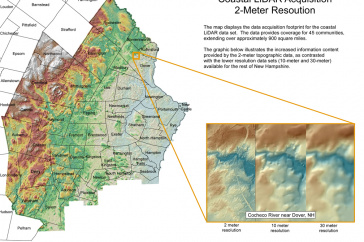Astrophysicists Available to Discuss Massive Sunspot, Powerful Solar Flare

New Hampshire coastal LiDAR acquisition footprint. Download full-size photo.
DURHAM, N.H. - Two scientists from the University of New Hampshire's Space Science Center within the Institute for the Study of Earth, Oceans, and Space are available to discuss the implications of the powerful solar flare that erupted from the sun around midnight May 16, 2012.
Harlan Spence (603-862-0322; harlan.spence@unh.edu), principal investigator (PI) of the Cosmic Ray Telescope for the Effects of Radiation (CRaTER) instrument onboard NASA's Lunar Reconnaissance Orbiter (LRO) mission, and Nathan Schwadron (603-862-3451; nschwadron@guero.sr.unh.edu), deputy PI on CRaTER and PI on the Earth-Moon-Mars Radiation Environment Module being developed at UNH, can both provide expertise and context.
An enormous sunspot some 99,400 miles across that has been producing increasingly intense solar activity over the last couple of weeks exploded and generated a powerful type of radiation release - an M-class flare - that could create damaging radiation storms on Earth over the next several days. Such storms can disrupt satellites that operate global positioning systems and other devices, create widespread radio blackouts, and lead to rerouting of airline flights over polar regions.
The large event was observed near midnight on Wednesday, May 16, through the early morning of Thursday, May 17, and is one of the largest eruptions seen since late January when the sun began to wake up from an extended quiet period. The flare produced potentially hazardous radiation exposure to thinly shielded materials in space. It also produced ground-level enhancements, or GLEs, which are sudden, sharp, and short-lived increases in cosmic ray intensities registered by neutron monitors on Earth. The GLEs from this event were the first to be seen in over five years.
For further information on Spence and Schwadron and their research, visit
http://www.eos.unh.edu/Faculty/spence
http://www.eos.unh.edu/Faculty/Schwadron.
The University of New Hampshire, founded in 1866, is a world-class public research university with the feel of a New England liberal arts college. A land, sea, and space-grant university, UNH is the state's flagship public institution, enrolling 12,200 undergraduate and 2,300 graduate students.
-30-
Latest News
-
July 2, 2024
-
June 18, 2024
-
June 18, 2024
-
May 17, 2024
-
May 14, 2024

















































